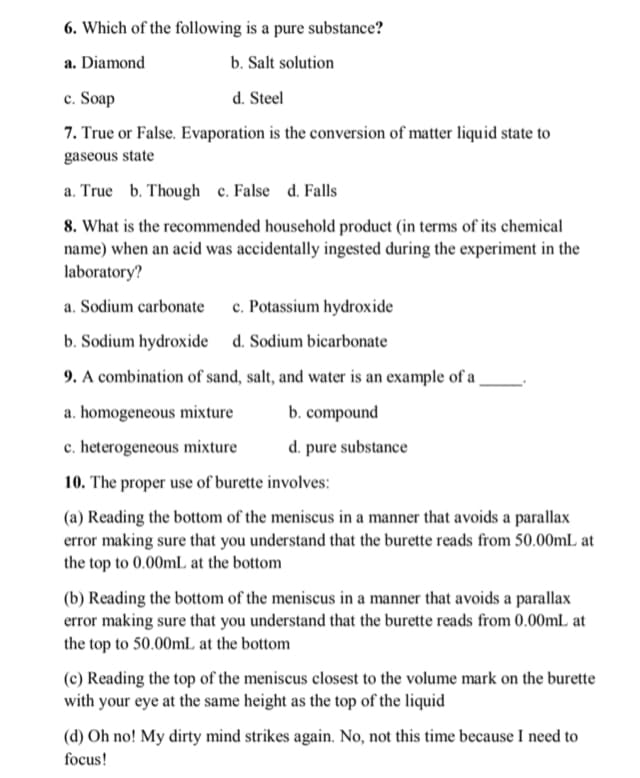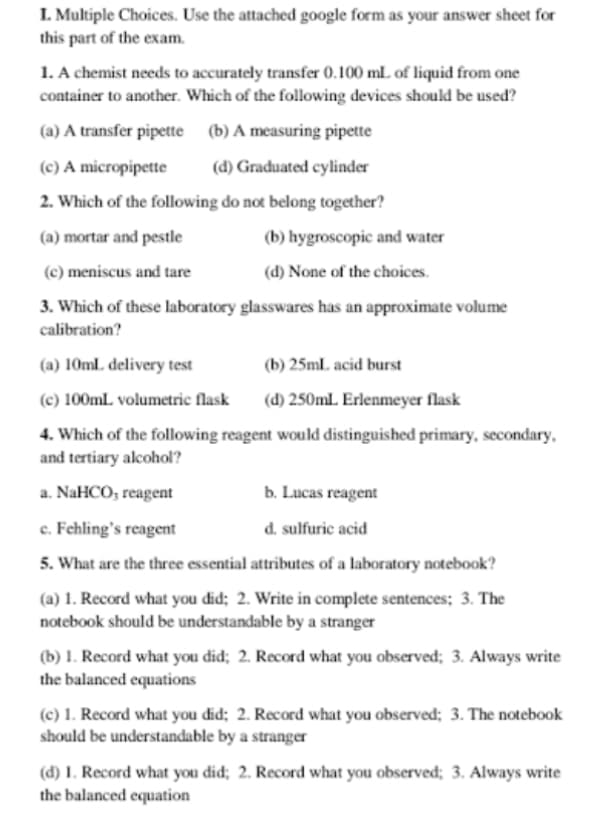Chemistry
10th Edition
ISBN:9781305957404
Author:Steven S. Zumdahl, Susan A. Zumdahl, Donald J. DeCoste
Publisher:Steven S. Zumdahl, Susan A. Zumdahl, Donald J. DeCoste
Chapter1: Chemical Foundations
Section: Chapter Questions
Problem 48E: Although the preferred SI unit of area is the square meter, land is often measured in the metric...
Related questions
Question

Transcribed Image Text:6. Which of the following is a pure substance?
a. Diamond
b. Salt solution
c. Soap
d. Steel
7. True or False. Evaporation is the conversion of matter liquid state to
gaseous state
a. True b. Though c. False d. Falls
8. What is the recommended household product (in terms of its chemical
name) when an acid was accidentally ingested during the experiment in the
laboratory?
a. Sodium carbonate
c. Potassium hydroxide
b. Sodium hydroxide d. Sodium bicarbonate
9. A combination of sand, salt, and water is an example of a
a. homogeneous mixture
b. compound
c. heterogeneous mixture
d. pure substance
10. The proper use of burette involves:
(a) Reading the bottom of the meniscus in a manner that avoids a parallax
error making sure that you understand that the burette reads from 50.00mL at
the top to 0.00mL at the bottom
(b) Reading the bottom of the meniscus in a manner that avoids a parallax
error making sure that you understand that the burette reads from 0.00mL at
the top to 50.00ML at the bottom
(c) Reading the top of the meniscus closest to the volume mark on the burette
with your eye at the same height as the top of the liquid
(d) Oh no! My dirty mind strikes again. No, not this time because I need to
focus!

Transcribed Image Text:I. Multiple Choices. Use the attached google form as your answer sheet for
this part of the exam.
1. A chemist needs to accurately transfer 0.100 mL of liquid from one
container to another. Which of the following devices should be used?
(a) A transfer pipette (b) A measuring pipette
(c) A micropipette
(d) Graduated cylinder
2. Which of the following do not belong together?
(a) mortar and pestle
(b) hygroscopic and water
(c) meniscus and tare
(d) None of the choices.
3. Which of these laboratory glasswares has an approximate volume
calibration?
(a) 10ml. delivery test
(b) 25ml. acid burst
(c) 100mL volumetric flask
(d) 250mL Erlenmeyer flask
4. Which of the following reagent would distinguished primary, secondary,
and tertiary alcohol?
a. NAHCO, reagent
b. Lucas reagent
c. Fehling's reagent
d. sulfuric acid
5. What are the three essential attributes of a laboratory notebook?
(a) 1. Record what you did; 2. Write in complete sentences; 3. The
notebook should be understandable by a stranger
(b) 1. Record what you did; 2. Record what you observed; 3. Always write
the balanced equations
(c) 1. Record what you did; 2. Record what you observed; 3. The notebook
should be understandable by a stranger
(d) 1. Record what you did; 2. Record what you observed; 3. Always write
the balanced equation
Expert Solution
This question has been solved!
Explore an expertly crafted, step-by-step solution for a thorough understanding of key concepts.
Step by step
Solved in 4 steps

Knowledge Booster
Learn more about
Need a deep-dive on the concept behind this application? Look no further. Learn more about this topic, chemistry and related others by exploring similar questions and additional content below.Recommended textbooks for you

Chemistry
Chemistry
ISBN:
9781305957404
Author:
Steven S. Zumdahl, Susan A. Zumdahl, Donald J. DeCoste
Publisher:
Cengage Learning


Chemistry: Principles and Reactions
Chemistry
ISBN:
9781305079373
Author:
William L. Masterton, Cecile N. Hurley
Publisher:
Cengage Learning

Chemistry
Chemistry
ISBN:
9781305957404
Author:
Steven S. Zumdahl, Susan A. Zumdahl, Donald J. DeCoste
Publisher:
Cengage Learning


Chemistry: Principles and Reactions
Chemistry
ISBN:
9781305079373
Author:
William L. Masterton, Cecile N. Hurley
Publisher:
Cengage Learning

Introductory Chemistry: An Active Learning Approa…
Chemistry
ISBN:
9781305079250
Author:
Mark S. Cracolice, Ed Peters
Publisher:
Cengage Learning

Chemistry for Engineering Students
Chemistry
ISBN:
9781337398909
Author:
Lawrence S. Brown, Tom Holme
Publisher:
Cengage Learning

Introductory Chemistry: A Foundation
Chemistry
ISBN:
9781337399425
Author:
Steven S. Zumdahl, Donald J. DeCoste
Publisher:
Cengage Learning